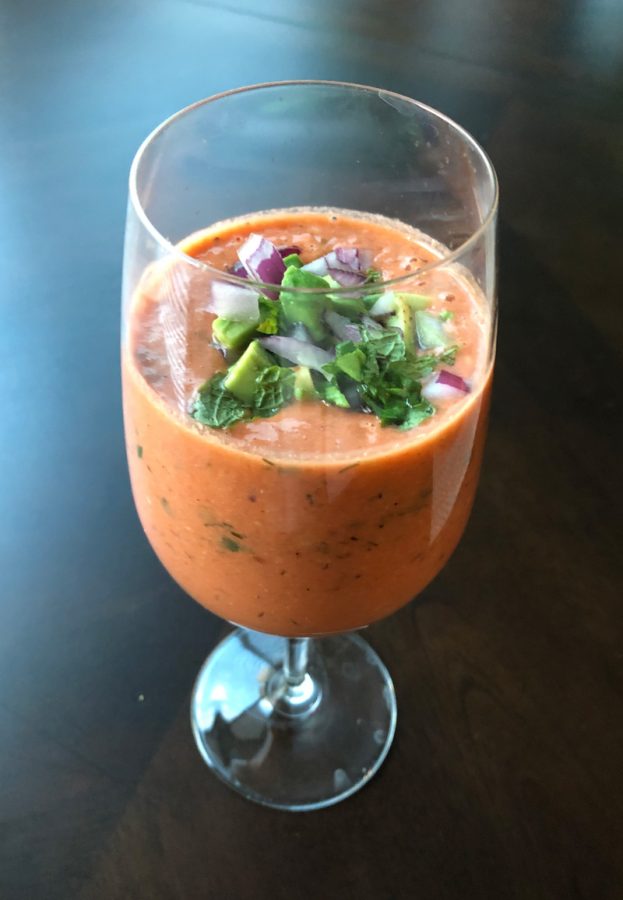Late-season melons bring sweetness to Yom Kippur meal, before or after fast
Published October 4, 2019
With farmers markets open well into October, you can still pick up the last of the tomato and corn crop, along with fall vegetables and fruits including eggplant, squash, chard, salad greens, broccoli, cauliflower, apples and pears. The colors of these fruits and vegetables mirror the leaves as they start to turn; it is the autumnal colors that make me want to fill my market bags with far more food than two people can eat.
The biggest surprise this year, however, has been the number of melons still available at farmers markets and local supermarkets. And with Yom Kippur just a week away, being able to include melon on your Yom Kippur menu, both pre- and post-fast, is a rare bonus.
Melons are naturally sweet, nutritious and super hydrating. More importantly, you can combine them with so many other foods to create delicious soups, salads, salsas for meat and chicken dishes and elegant desserts. While biting into a cold wedge of watermelon, with or without salt, is thirst-quenching and satisfying on its own, pureeing that watermelon with tomatoes and a few other vegetables makes a sweet, savory and delicious gazpacho just right for beginning your holiday meal.
I spoke with Ann Thies of Thies Farm, where melons are a late crop, planted soon after they harvest their strawberries. Her farm grows seeded and seedless watermelons, cantaloupes, canary melons and sensation melons.
“Canary melons are a hybrid between cantaloupes and honeydew melons,” Ann said. “The flesh is yellow and very sweet. The outside of the melon is bright yellow and has ridged grooves from end to end. Sensation melons are on the sweeter side of a cantaloupe, the outside of the melon similar in color and texture to a cantaloupe but smaller.”
Thies Farm melons are available at its markets at 4215 N. Hanley Road in the city and 3200 Greens Bottom Road in St. Charles, possibly through early October.
Other local melon varieties to look for include: casaba, a type of muskmelon whose flesh is a bit softer and works well in smoothies and salsas; crenshaw, perhaps the sweetest of all melons with a yellow rind and salmon-colored flesh; and galia, which look like cantaloupes on the outside and honeydews on the inside.
A category of melons I’ve recently seen in the supermarket is “Kiss” melons: Honey Kiss and Sugar Kiss, the latter being particularly sweet with softer flesh.
There is no foolproof method for selecting the perfect melon, however following these tips may help:
1. Look for melons whose rinds are free of blemishes, heavy for their size and hollow-sounding when tapped.
2. Some cantaloupes will smell sweet where they were cut from the vine, but that isn’t always the case.
3. Keep in mind that, with the exception of watermelon, uncut melons will continue to get sweeter after sitting on your kitchen counter for two or three days.
4. A riper melon does not always mean a sweeter one. Ask the farmer at the market or your supermarket’s produce manager to help you select the best one.
At a recent Shabbat dinner hosted by our friends Carol Rubin and Howard Schlansky, Carol served what has become my new favorite salad. This beautifully layered salad requires no recipe, and the ingredients magically complement each other. Just be sure that all the components are fresh.
To make this yummy salad, simply layer chilled watermelon wedges, sliced vine-ripe tomatoes and slices of fresh mozzarella cheese on individual plates. Decoratively drizzle each serving with balsamic syrup and garnish with a small handful of bright-green fresh basil leaves. Drizzle some extra virgin olive oil over the top and finish with some freshly ground black pepper. It’s that simple!
To make a sweet and savory melon salsa to serve alongside roasted chicken, dice and toss two cups of your favorite melon (do not use watermelon) in a medium bowl along with a teaspoon of finely grated fresh ginger, a tablespoon of freshly squeezed lime juice, and salt and pepper to taste. Cover salsa and refrigerate for at least 30 minutes before serving.
I have included below three other recipes that pair melon with other vegetables and fruits, all great additions to your holiday menu.
Oh, and no Yom Kippur meal would be complete without apples. I have also included a recipe for my favorite frangipane galette. Though I have added both peaches and blackberries to my galette, you may prefer using other fresh fruits, or just apples. I would suggest using the apples two ways: chopped over the frangipane, as in the recipe, and thinly sliced on top.
G’mar Hatima Tova.
Margi Lenga Kahn is the mother of five and grandmother of seven. A cooking instructor at the Kitchen Conservatory, she is working on a project to preserve the stories and recipes of heritage cooks. She welcomes your comments and suggestions at [email protected].
















